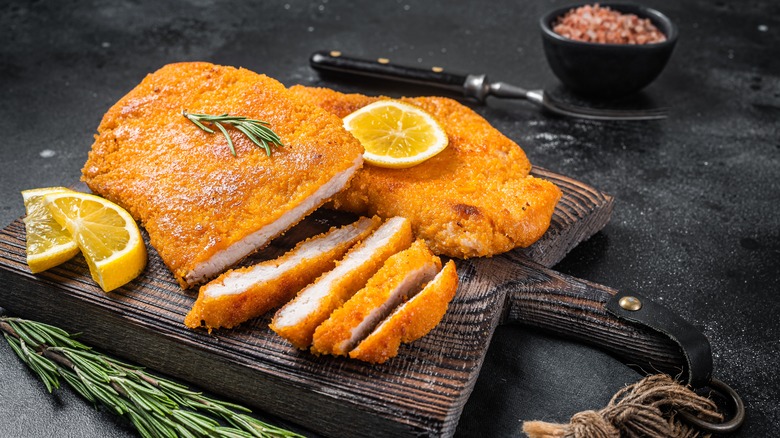How Thin You Should Make Wiener Schnitzel
A crispy and golden-crusted Wiener schnitzel is a classic Austrian dish for good reason: the thinly-sliced dish is a staple for both its historic ties to Vienna and simplistic makeup. The dish itself means "Viennese Schnitzel" in German per the BBC (i.e., meat from around the area of Vienna) and is steeped in the country's modern traditions and beyond. Seriously, there must be some type of magic in that combination of breadcrumbs, flour, and salt to make a simple cutlet of veal taste so good.
If you're scouring websites for a good Wiener schnitzel recipe and all the authentic sides that go with it from German potato salad to pommes, there are a few things to remember. One, you can call versions of this dish made from veal Wiener schnitzel, according to the BBC. Any other type of meat, such as the more cost-effective option of pork, must be called Wiener schnitzel vom Schwein (AKA "from pork"), or simply schnitzel. One of the most integral parts of making the perfect version of this veal dish, however, is to pound it to the exact right, coin-thin consistency.
The origins (and fables) behind this beloved European dish
Shockingly enough according to National Geographic, the Wiener schnitzel may have not had its origins in Vienna at all, but Italy. The most widely spoken legend of this dish is that a similar breaded veal was spreading across the Italian peninsula all the way back in 1857. When an Austrian general of the time discovered it, he came back home and ordered his cooks to fry up a replica. This iteration became known as the Wiener schnitzel, which was given the title as a way to differentiate it from other fried meats from other countries like Italy, per the BBC.
According to the BBC, others claim that breaded schnitzels were found in Austrian cookbooks a century before 1857, and the name Wiener schnitzel itself even appeared in one from 1831. Still, no matter where it was truly founded, today it has become ingrained in the local tradition and is an integral part of Austrian culture. Per The Spruce Eats, the dish itself and the exact definition is even protected by Austrian law. One of the most iconic aspects of this legally protected dish is its thickness.
Exactly how thin you should be making your Wiener schnitzel
If you want to make a truly authentic Wiener schnitzel, one of the most characteristic parts of the dish you should get right is its thin form. While the word "thin" is a start as far as descriptors go, an exact measurement is always preferred — so we did a little digging to find out what exactly the most ideal thickness is. The answer? Anywhere between 2 and 4 millimeters. Here's why.
According to The Spruce Eats, German Chef Jennifer McGavin says pounding your Wiener schnitzel until it is about 1/4 inch thick is a great choice. The small width helps ensure you're enjoying a schnitzel exactly as it should be, plus veal pounded this thin only needs about five minutes of frying time. Per the BBC, the home of the self-dubbed "one true Wiener schnitzel" — Figlmüller in Vienna, to be exact — sets a very similar rule and says that schnitzel is best when it is 4 millimeters thick and 30 centimeters in diameter. And according to The Guardian, Austrian Michelin-starred chef Kurt Gutenbrunner opts for a veal that is 3 millimeters thick, although he also adheres to the 30-centimeter diameter rule.
There is a little bit of wiggle room as far as the thickness of a Wiener schnitzel goes, so generally, just make sure it's thin and you're on the way to crispy, golden satisfaction.


